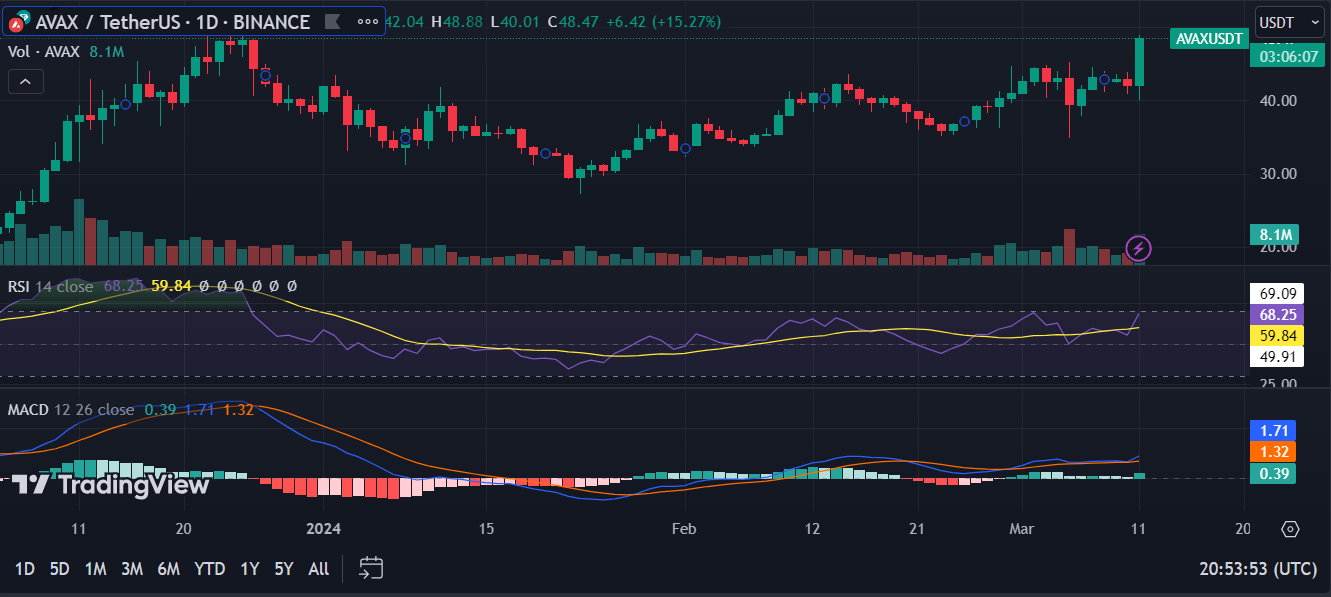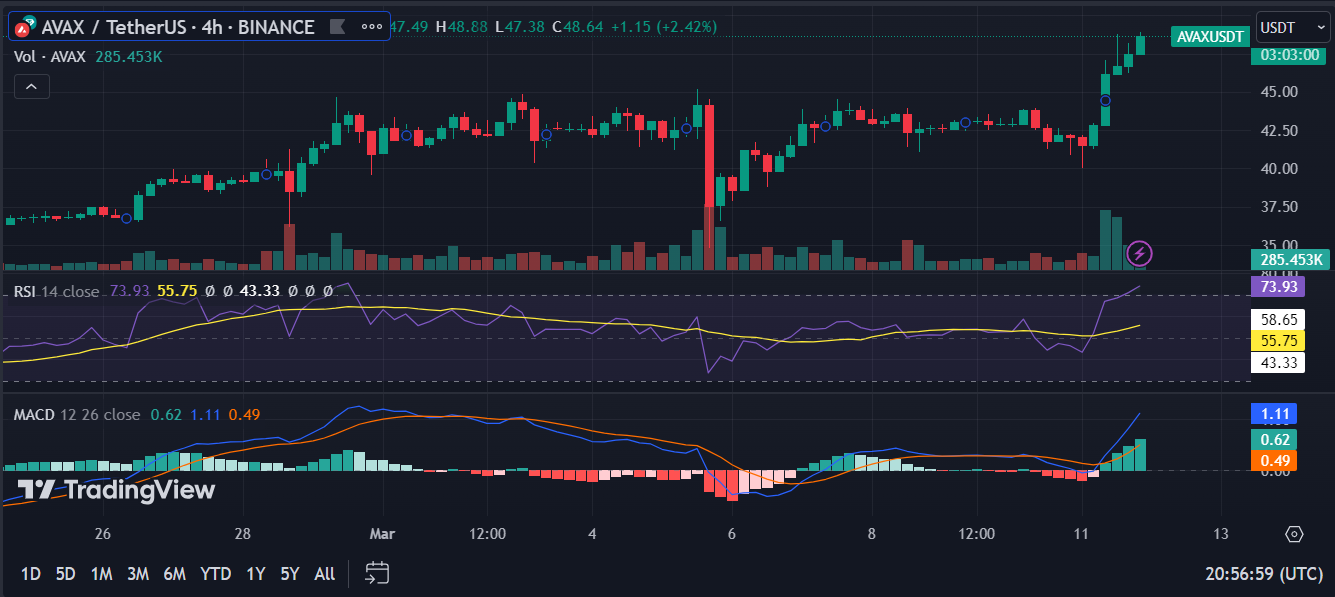and $834.53, respectively. In 2025, it will trade at a mean price of $106.67. It will reach a maximum price of $111.20 and a minimum of $92.06. In 2027, it will trade at a mean price of $186.15. It will reach a maximum price of $189.26 and a minimum of $165.17. In 2033, it will trade at a mean price of $824.40. It will reach a minimum of $805.21.
Avalanche Predictions By Industry Experts
Avalanche forecast by Binance, the world’s largest exchange by trading volume, indicates a bullish price projection; AVAX will average at $45.64 in 2025, $50.32 in 2027, and $58.25 in 2030.
Avalanche Overview
| MARKET CAP | CIRCULATING SUPPLY | POPULARITY | ALL-TIME LOW | ALL-TIME HIGH |
| $16.288 Billion | 377,259,824 | #11 | $2.79 | $146.22 |
Avalanche began as a protocol for solving for consensus in a network of unreliable machines, where failures may be crash-fault or Byzantine. The protocol’s fundamentals were first shared on the InterPlanetary File System (IPFS) in May 2018 by a pseudonymous group of enthusiasts named “Team Rocket.”
Researchers from Cornell University led by Emin Gün Sirer and doctoral students Maofan “Ted” Yin and Kevin Sekniqi later developed Avalanche. Following the research stage, a startup technology company was founded to develop a blockchain network that met finance industry requirements. In March 2020, the AVA codebase (Developer Accelerator Program or AVA DAP) for the Avalanche consensus protocol became publicly available as open-source software.
AVAX Price History
In September 2020, Avalanche issued its native token, Avax. On Dec 31, 2020, the coin hit an All Time Low at $2.7888.
In September 2021, the Ava Labs Foundation received a $230 million investment from a Polychain and Three Arrows Capital group by purchasing the AVAX cryptocurrency.
In November 2021, following an agreement with Deloitte to improve U.S. disaster relief funding, the Avalanche blockchain moved into the top 10 cryptocurrencies in capitalization. At that time, AVAX achieved its All-Time High at $146.22.
In August 2022, whistleblower “Crypto Leaks” published a report accusing Ava Labs of secret deals with a law firm aimed at legally destabilizing Avalanche’s competitors. Ava Labs CEO Emin Gün Sirer denies any dirty deal with Roche Freedmen law firm.
In 2023, AVAX maintained a bullish trend between January and May, after which bears overwhelmed the market. It resumed the positive momentum in October, rising to $49.96. It corrected to $40 in 2024.

Source:https://coinstats.app/coins/avalanche-2/
More on Avalanche/ AVAX:
The platform is fast, low-cost, and eco-friendly. Avalanche is fully compatible with Ethereum assets, apps, and tools with faster speeds, higher throughput, and lower fees. Applications include
- Asset Issuance,
- Borrowing and lending,
- Automated Market Makers (AMMs),
- Decentralized Exchanges (DEXs).
What is Avalanche & AVAX?
Ava Labs believes in the Avalanche protocol’s objective to construct a strong, safe, and power-efficient cryptocurrency network for apps (“dApps”), unique payment primitives, and new interconnecting blockchains. The Avax protocol is developing a new tokenized economy via its revolutionary technological approach, which includes seamless physical & virtual asset trade, modular payment application primitives and derivative products, Web 3.0 private data and social apps, and much more.
Avalanche is one of the blockchain sector’s fastest smart contracts cryptocurrency networks. The network’s high number of PoS validators ensures efficiency. Furthermore, the Avalanche network is a lightning-fast, low-fee, and environmentally friendly platform. Again, any smart contract-based application might surpass its rivals on Avalanche.
Avalanche’s mainnet went live on September 21, 2021, and ever since, the platform has secured multiple projects, over $23.63 million of AVAX fees burnt, about 1,200 other block-offering validators, and over 958,000 community members on X.
What makes Avalanche the best smart contracts platform?
- The Web’s Next Generation
Avalanche and other cryptocurrency networks are next-generation web app platforms. The web is constantly changing. Web 1.0 PC networks linked us to the web and access to information and electronic online commerce payments. Web 2.0 mobile-first social networks linked us to internet communities, while algorithms enhanced our data user experience. Web 3.0 cryptocurrency networks are trustless community-based protocols such as Avalanche, which offers consumers back control over their information and privacy via natively incorporated DeFi apps.
- The third age of cryptocurrency innovation:
Earlier cryptocurrency networks allowed for worldwide, decentralized virtual money. The 2nd wave of platforms expanded on this foundational technology to enable the construction of programmable dApps, enabling DeFi devices, NFTs, and other revenue-generating applications. These systems, however, have serviced a restricted range of use cases because of high-cost implications for transactions and slow transaction speeds. The third generation of cryptocurrency networks intends to accommodate a wider variety of decentralized Apps on less expensive and quicker blockchains, ushering in a multi-chain future with many ecosystems competing on speed, safety, and customization.
- Innovative technological architecture
Avalanche uses revolutionary consensus means and a one-of-a-kind feature to provide a quick and scalable solution. Avalanche is a proof-of-stake (“PoS”) network that leverages probabilistic agreement to protect payments while maintaining performance and scalability. Avalanche’s distinctive multi-chain design makes it a blockchain platform, with several “subnets” supporting varied customer demands. This primary feature essential operations native to distinct subnets to interoperate effortlessly, without performance deterioration seen in networks when all activity is piled onto a single chain.
- Reliable network fulfillment
Base-layer decentralized network technology protocols to host various applications and develop a robust digital economy must provide an optimum balance of decentralization, safety, and scalability while charging cheap transaction costs. Avalanche’s main net provides a transaction resolution layer that is highly competitive with the top PoS and PoW cryptocurrency systems in various criteria.
- Early uptake is encouraging.
The capabilities of Avalanche have made it appropriate for many 3rd developers who are quickly launching new DeFi solutions on the Avax C-Chain. Decentralized exchanges, liquidity mining, loans, synthetic assets, and other services are available via dApps. Consequently, the network has seen a significant increase in assets, apps, and bespoke execution on subnets targeted to corporations and bodies introduced briefly since the main net went online. This increased use has resulted in a continuous increase in transaction fee income to the network, supporting the tokens’ economic worth. Remember, the Avalanche blockchain was meant to help dApp developers deploy products on active subnets, just like the Ethereum virtual machine.
- Risks and uncertainty:
Failing to implement its product plan, delayed system governance rollout, declining developer cravings, dApps not acquiring significant demand, rival cryptocurrency networks gaining share, user and transaction cost implication income do not materialize, crypto volatility, and regulatory concerns.
Avalanche provides a new form of consensus and flexibility that other Layer 1.0 protocols do not offer. While the system is still in its early stages, its degree of acceptance indicates that blockchain developers are aware of its potential and expect Avalanche to achieve its vision of a scalable and extensible digital world more than other blockchains.
Avalanche Features
The Platform Chain (P-Chain), the Exchange Chain (X-Chain), and the Contract Chain are all incorporated into Avalanche (C-Chain). All three blockchains are authenticated and secured by Avalanche’s fundamental network.
- The P-Chain is a network of interconnected nodes (Platform Chain).
Avalanche’s metadata blockchain, which controls authenticators and custom subnets, is known as the P-Chain. Validators stake AVAX on the P-Chain to defend the network.
- The X-Chain is a network of interconnected computers.
The X-Chain is Avalanche’s default asset blockchain, allowing asset building and trading. This Avalanche blockchain is designed for transactions requiring high throughput and quick completion (for dApps, use the C-Chain).
- The C-Chain is a series of links in a chain (Contract Chain).
The C-Chain is Avalanche’s default smart contract blockchain, letting developers create Ethereum-compatible programs and assets at lower prices and quicker transactions.
Conclusion
The future of Avalanche (AVAX) holds both promise and uncertainty as it continues to establish its position in the blockchain industry. With its focus on scalability, fast transaction processing, and unique features like decentralized governance and fee structures, Avalanche has gained attention as a potential competitor to established platforms like Ethereum.
Looking ahead, the price prediction for AVAX from 2024 to 2033, investment advice, and your research may present a range of possibilities. While it is challenging to accurately forecast the exact trajectory of any cryptocurrency from the current Avalanche price, several factors contribute to its potential growth. These include its expanding ecosystem, increasing adoption of the Avalanche platform, and advancements in technology that improve transaction speeds and scalability.
Additionally, broader market trends, regulatory developments, and investor sentiment toward cryptocurrencies will influence AVAX’s performance. As the blockchain industry continues to evolve, competition among platforms intensifies, and market dynamics shift, it is crucial to consider both the opportunities and risks associated with AVAX. Remember to conduct own research if you intend to invest.


